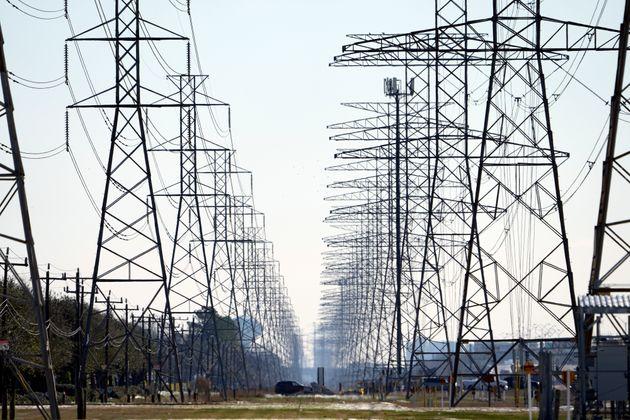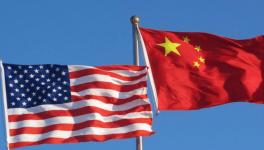Cost of Deregulation? Human Sufferings in Texas Triggered by Power Outages for Days

Image Courtesy: HuffPost
Print and digital media worldwide have reported a major unprecedented calamity of electric power outages in Texas between February 15-20, 2021. This was caused by once-in-a-century sub-freezing temperatures in the range of 1-12 degree Fahrenheit (-17 to -11 degree Celsius). Apparently, a part of the polar vortex in the North Pole escaped the polar region and came down via Canada and went through the entire central region of the United States -- from Chicago to Texas in the Deep South. Prolonged lack of power supply meant there was no heating in homes amid sub-freezing temperatures as millions of people suffered, and some elderly and vulnerable people froze to death.
Many cities and towns could not operate their water processing plants because of prolonged lack of electricity. These jurisdictions, consisting of half of the Texas population, advised their residents to boil water for drinking. Most people had electric operated cooking ranges at home which could not be used for boiling water! Limited supply of bottled water was the only recourse in those communities. Additionally, really cold temperatures in unheated homes caused the water in the pipes to freeze and crack the pipes. Busted water pipes inside homes caused major water damages and limited flooding in many Texas homes - a triple whammy!
The scale of prolonged human sufferings by millions of people was unimaginable unless a community really goes through this once in a century calamity. The worst part was that a calamity of this magnitude was entirely avoidable with prior investments in energy infrastructure and proper planning. How could this happen in Texas -- the largest energy producing state in the United States? How did the millions of people affected by this disaster cope with it? Let us dive in.
SCALE OF HUMAN SUFFERINGS
First, we will focus on the scale of human sufferings since the author has been living in the Dallas area for the last 20 years. In the major Texas cities like Dallas, Houston, San Antonio and even all over Texas, people know how to prepare against hurricanes and flooding in the coastal areas in spring and autumn. During these seasons, weathers are much milder. In Dallas -- Fort Worth area in north Texas -- temperatures dip slightly below freezing a few times during winter. With predictions of extremely cold temperature for a week and 4-6 inches of snow, people prepare with food, water, blankets, flash lights, candles etc. A day before the winter freeze hit Texas, Energy Reliability Council of Texas (ERCOT), the non-profit agency that manages the state's power grid, warned people that there will be rotating blackouts of 1-2 hours at a time. Residents of Texas were completely unprepared by the government agencies and the power utility companies for the scale of the disaster that followed.
When the winter freeze and the snow storm hit Texas, a major spike in consumer demand for home heating followed. Simultaneously, frozen equipment in power generating plants and diminished raw energy supply because of frozen natural gas well-heads caused a major danger to the stability of the power grid. Approximately 40% reduction in power generation caused a huge gap with the simultaneous spike in demand.
Since electricity cannot be stored, supply and demand has to match on an ongoing basis. In order to prevent a complete collapse of the power grid, ERCOT instructed regional and local power distribution companies to power down large areas and neighbourhoods aggressively. Instead of rotating blackouts of short durations, many communities got only 1-2 hours of power after a period of 12-18 hours. Many other communities did not receive any power at all for three to five days. Some really unlucky communities did not get any power for a week! Sometimes, a part of an area or a city had stable power while the other parts of the same city stayed in continuous darkness. It was extremely haphazard.
Impacts of prolonged power outage on the population in arctic temperatures were devastating:
- No home heating, approximately four million people got very seriously affected.
- No cooking since cooking ranges in most homes are electric; a small percentage of homes has gas cooking ranges.
- 15 million people, about half of the state population, were advised to boil water for drinking, which was not possible without electricity. Limited supply of bottled water did not last long for many families.
- Roads had 4-6 inches of ice and snow, driving on the roads was very treacherous.
- Elderly couples and singles in their seventies and eighties with underlying health conditions constitute a significant part of US households. There was no prior warning for evacuating them to safer locations with family members or friends.Total deaths of the elderly and vulnerable people are in the range of 100+, with numbers climbing every week. In comparison, a major hurricane named Harvey killed about 75 people last year in Texas.
- Inside many homes, water in the pipes froze to ice in the prolonged absence of any home heating. These frozen pipes burst and there were major water damages. Where damages and flooding were extensive in homes, the residents had to flee after 1-2 days to stay with their friends in nearby areas with stable electricity and home heating.
- This winter storm is projected to be the costliest weather event in Texas history. The combined damage to energy infrastructure and private property is expected to exceed $20 Billion (with a B). No dollar figure can adequately measure the extreme misery inflicted on the millions of Texas residents for days together and avoidable death of 100+ vulnerable people.
EXEMPLARY VOLUNTEER ACTIVITIES
Once the scale of the disaster was understood by the people of Texas in the first 12-24 hours, the residents sprang into action. People who stayed home, lit small fires in the fireplaces to stay warm. Many had to layer up with blankets and huddle together. Neighbours checked on neighbours and offered help. Young volunteers drove elderly residents to temporary warming shelters set up by the cities, towns and churches.
Cities and towns set up designated locations for distributing free water bottles where city water was not drinkable. Some restaurants had power cooked meals and delivered free food to the worst-affected poor areas. People kept in touch with friends and relatives through occasional use of cellphones and social media. Thousands of volunteers called elderly people all over Texas using telemarketing lists to check on their status and find out what they needed most. Volunteers used innovative ways of arranging help a few hundred miles away using social media. It was a monumental volunteer effort by many groups and individuals. It probably saved thousands of lives and mitigated extreme hardships for hundreds of thousands of people.
POWER UTILITY REGULATORY ENVIRONMENT IN TEXAS
Power utility companies in each state in the US except Texas are currently regulated by the respective state regulator. Northern and eastern states, which face extreme cold temperatures every year, are regulated by the state regulators to ‘winterize’ their power generation plants - appropriate insulation of pipes and equipment, and extra heating elements to prevent freezing of critical parts of equipment. Additionally, the power generation companies have to store adequate input raw materials onsite and maintain extra generation capacity to handle emergencies. Since electricity cannot be stored, supply has to match demand on an ongoing basis. This requires adequate planning, investments for safety measures and maintaining extra capacities at multiple levels to handle emergencies and spike in demand.
The power utility regulator at the federal level came into existence in the United States in the 1930s. If a power transmission line in a state crosses over to another state, then that state comes under the purview of the Federal Regulator. Texas politicians decided that the Texas power grid would sever all connections with the national power grid to escape any oversight by the Federal Regulator. As far as power generation and transmission were concerned, the Texas power grid operated like a separate island! Texas could not take any power from a neighbouring state in an emergency situation, nor could she give any power to a neighbouring state to mitigate any emergency. So, the seeds for the current disaster were sown by the Texas politicians approximately ninety years ago!
There are only two exceptions to this separate power grid policy in Texas The first one involves the small city of El Paso and the neighbouring areas in the southwest corner of Texas bordering Mexico. This remote part of Texas is part of the western grid in North America spanning western parts of Canada, United States and Mexico. The other exception is the eastern edge of East Texas, which is part of the eastern grid in North America. When all 254 counties in Texas had below freezing temperatures with disastrous consequences on its power supply, the small city of El Paso and the eastern edge of East Texas survived relatively unscratched and kept their lights on! Will the current crop of Texas politicians learn something valuable from these points? As they say in Texas, "I will not bet my cattle or ranch on that."
BACKGROUND OF POWER DEREGULATION IN TEXAS
Until 1999, Texas had strict regulation of its power utility companies similar to other 49 states in the union. In an informative article in the New York Times, Clifford Krauss and his colleagues described how the drive for energy independence and "Republic of Texas" mindset led Texas to aggressively deregulate its electric power business in 1999 by embarking on an experiment. Texas started handing over control of its entire electrical delivery system to a market-based patchwork of private power generation, transmission and energy retail companies. At that time, both political parties in the state supported this move. George W. Bush, then Governor of Texas (later President), said in a bill signing ceremony, "Competition in the electrical industry will benefit Texans by reducing monthly rates and offering consumers more choices about the power use."
Under Governor Rick Perry in 2002, Texas further deregulated, essentially dismantled its regulatory regime for 85% of the power consumers in the state and handed over the keys of the kingdom to a highly uncoordinated group of private companies ( electricity generators, transmission companies and retail distributors) with nobody in charge of the power grid to enforce any safety rules or make necessary investments. The remaining 15% of the consumers continued to be served by traditional regulated utilities run by small municipalities or cooperatives. The non-profit agency ERCOT which operates the Texas power grid cannot mandate any safety or ‘weatherization’ rule on the power generating companies. It can only review weatherization plans and make suggestions. The Governor appoints three board members of the Public Utility Commission (PUC) in Texas. It sets up the maximum price a power generation company may charge to a retail power distribution company. This rate is currently set at $9/Kilowatt hour. Under normal conditions, this rate is only a few cents per kilowatt hour. PUC can also levy penalties on power generators and distributors It can also reverse charges to consumers which PUC does very rarely.
The entire electricity delivery setup was predicated on introducing competition and maximising profit with no mandatory safety or weatherization requirements for the power generating companies. These companies were supposed to make the "right decisions" solely driven by profit motives. Some astute observers compared this situation with abolishing speed limits on highways and the roads with no traffic police patrolling highways and the roads to ensure safety. Obviously, some people will cut corners for increasing profit and disasters are bound to happen.sooner or later.
FIRST MAJOR WINTER FREEZE IN 2011 AFTER DEREGULATION
The first major winter freeze in Texas after the deregulation coincided with the Super Bowl ( American football championship final) held in Dallas in 2011. More than three million people lost power in parts of Texas in freezing temperatures. This was a major hardship for the people and an embarrassment for the state with national attention focused on Dallas because of the Super Bowl.
The North American Electric Reliability Council (NERC) -a non-profit agency and the Federal Energy Regulatory Commission held detailed enquiries and published their recommendations. They advised Texas to implement stringent safety measures and winterize the power generation plants at multiple levels. Only the Texas Legislature had the authority to mandate implementation of some or all of these recommendations. Instead of doing that, the legislature decided to mandate that the power generation companies will have to submit their Emergency plans to ERCOT twice a year. These plans will describe what they will do in case of extreme cold or heat waves. Power generators were not required to take specific steps to winterize their equipment -- adding de-icing machines to wind turbines or adding insulation on valves and sensors for plants fuelled by natural gas. The state laid out best practices. But these were only recommendations, not mandatory requirements.
The Texas Public Utility Commission fined two companies in 2011 after the fact because they could not supply power during the winter storm they were obligated to provide as per their contracts . One company was fined $750,000 and another one $25,000. These paltry amounts were less than a slap on the wrist for the two power generation companies. Even after a major power disaster in 2011 with national attention, Texas law makers chose to adopt a "all carrot, very little stick" approach for the power generating companies. Executives in most of these companies made business decisions to maximize their profits. In the absence of mandatory requirements, there was very little incentive for power generating companies to invest in costly weatherization measures and lose market share in the process.
It was mentioned earlier that the Texas power grid is an island by itself. Texas is the only state that does not have any fall back option to borrow power from the national grid in case of emergency situations. So, the stage was set for the next power emergency to hit Texas sooner or later.
SECOND MAJOR WINTER FREEZE IN 2021 AFTER DEREGULATION
The winter freeze in 2021 was far worse than the winter freeze in 2011. Initial reaction of the Texas politicians was to deflect the blame to ERCOT and others. Within a day, Governor Abott went on Fox News and started a disenguous misinformation campaign by blaming the renewable energy sector and frozen wind turbines for the power outages. Other Texas politicians joined the chorus. The conservative right wing media and politicians kept on warning people about the dangers of relying on renewable energy in future. In reality, Texas gets 25% of its power from wind and solar during warmer weather. Natural gas accounts for more than twice that much. But in winter time, wind and solar accounts for only 7% of the total power Texans consume. Some gas turbines froze because of lack of heating coils and winterization. But the major causes of power outages this time were lack of winterization in power plants run by natural gas, frozen natural gas wellheads and some natural gas processing plants closing down because of lack of electric power. This turned out into a vicious downward cycle.
Because of the evolving climate change in the coming decades, this will not be the last major climate event in Texas. Luckily, the Texas legislature is in session now. As per the Texas constitution, the Texas legislature meets once in two years from January to June in every odd year. The Governor has the power to call the legislature back for a special session any time. All members of the Texas House, half of the Texas Senate and the Governor will be up for re-election in November 2022. So, the stakes are quite high and some mitigation steps are expected to be passed in this legislative session.
Astute observers of Texas politics predict that once the Texans' lives go back to normal in spring weather, the Texas legislature and Governor Abbott will make modest tweaks in the 2002 electricity deregulation laws to make weatherization of power generating plants mandatory. It is highly unlikely that the legislature will make any fundamental change in the regulatory regime. Cal Jilson, the political science professor at Southern Methodist University, Dallas noted, "The core Republican vision of Texas public policy is deeply felt. They believe it in their bones. There's a powerful commitment to that base ideology of small government, low taxes and deregulation." Additionally, most of the power and energy barons in Texas are major donors of the dominant Republican party. Most likely, the core beliefs of the Republican leaders and the political influence of the power industry will prevail "and limit the amount of reform that is mandated." Jilson is the author of the book "Lone Star Tarnished" - a chronicle of how major state education, health and infrastructure programs are starved for money ever since the Republicans essentially took over Texas twenty years ago.
PRICE IMPACT OF TEXAS DEREGULATION
Tom McGinty & Scott Patterson reported that a Wall Street Journal study of consumer data in Texas found that since 2004, 85% of deregulated Texas consumers paid an astounding $28 Billion more for their power than they would have paid compared to the 15% of Texas consumers still under traditional utilities. This was not supposed to come out this way. The whole purpose of deregulation in 2002 was to give consumers multiple choices thereby driving consumer prices down.
Additionally, an estimated 20-25% Texas consumers are currently on a variable rate plan with their retail distribution company. For these consumers, the billing rate per kilowatt hour varies with the wholesale spot price based on supply and demand. During the recent crisis, the wholesale price of power reached the maximum rate of $9 per kilowatt hour for approximately five days. Some of these consumers were hit with a bill exceeding $5,000 - $10,000 in a few days. Average bill of a consumer in Texas in winter is in the range of $50-$75 / month. Most of these consumer contracts are very lengthy and the details are hidden in legal jargon and fine print. Gullible consumers possibly did not understand that the sky was the upper limit of a variable rate plan in case of a real power shortage in an emergency.
To add insult to injury, Potomac Economic, in its role as the Independent Market Monitor for the Texas Public Utility Commission, reported that ERCOT exceeded its mandate and overcharged the Retail Power Companies at the maximum rate for a period of 32 hours within the peak five day period. This resulted in a total overcharge of $16 Billion. Most of this overcharge was passed on to the end consumers by the Retail Power Companies. Public Utility Commission in a recent hearing refused to reverse the overcharge portion of the exorbitant bill to the Retail Power Companies and the end consumers. The Public Utility Commission cited unintended consequences of revering an overcharge that has already gone through the system! If you are wondering about the supposedly independent referee role of the Texas Public Utility Commission, you are not alone.
WHAT NEXT?
Texas is the proverbial belly of the beast in the US as far as power industry deregulation is concerned. How Texas proceeds from here, has implications far beyond the borders of Texas. Whether the Texas governing philosophy works for an essential service like electric power and whether we should continue to keep the Texas power grid totally isolated like an island are critical questions on the table for our wise legislators and the Governor of Texas.
Dear reader, If you are interested in knowing how the Texas politicians answered the critical questions listed above, please stay tuned. There will be a follow up article in Newsclick in May / June 2021 after a bill is passed in the Texas legislature and signed into law by our Governor.
Subir Purkayastha is an activist living in the US for 51 years, last 20 years in the Dallas area.
Get the latest reports & analysis with people's perspective on Protests, movements & deep analytical videos, discussions of the current affairs in your Telegram app. Subscribe to NewsClick's Telegram channel & get Real-Time updates on stories, as they get published on our website.






















